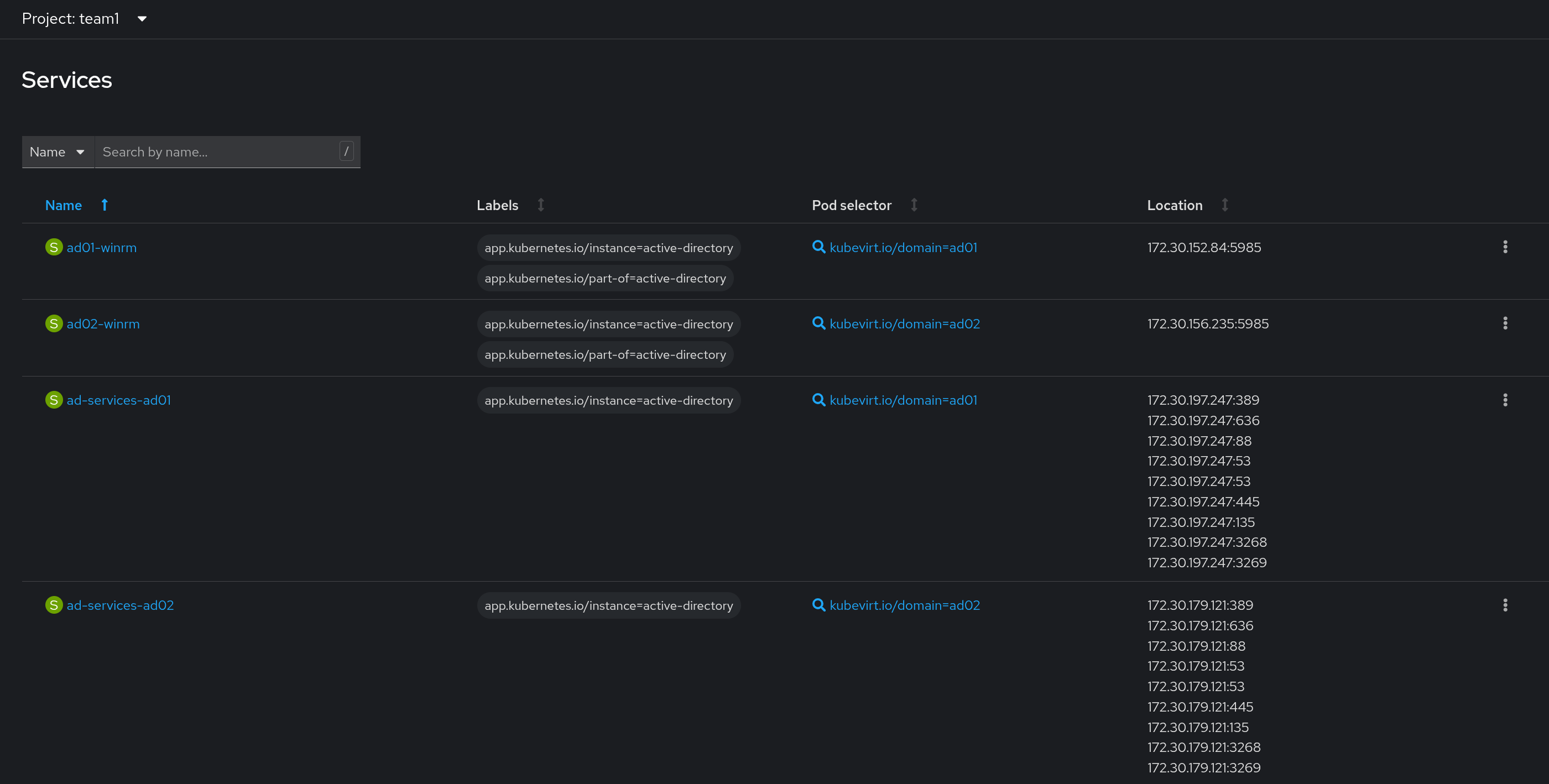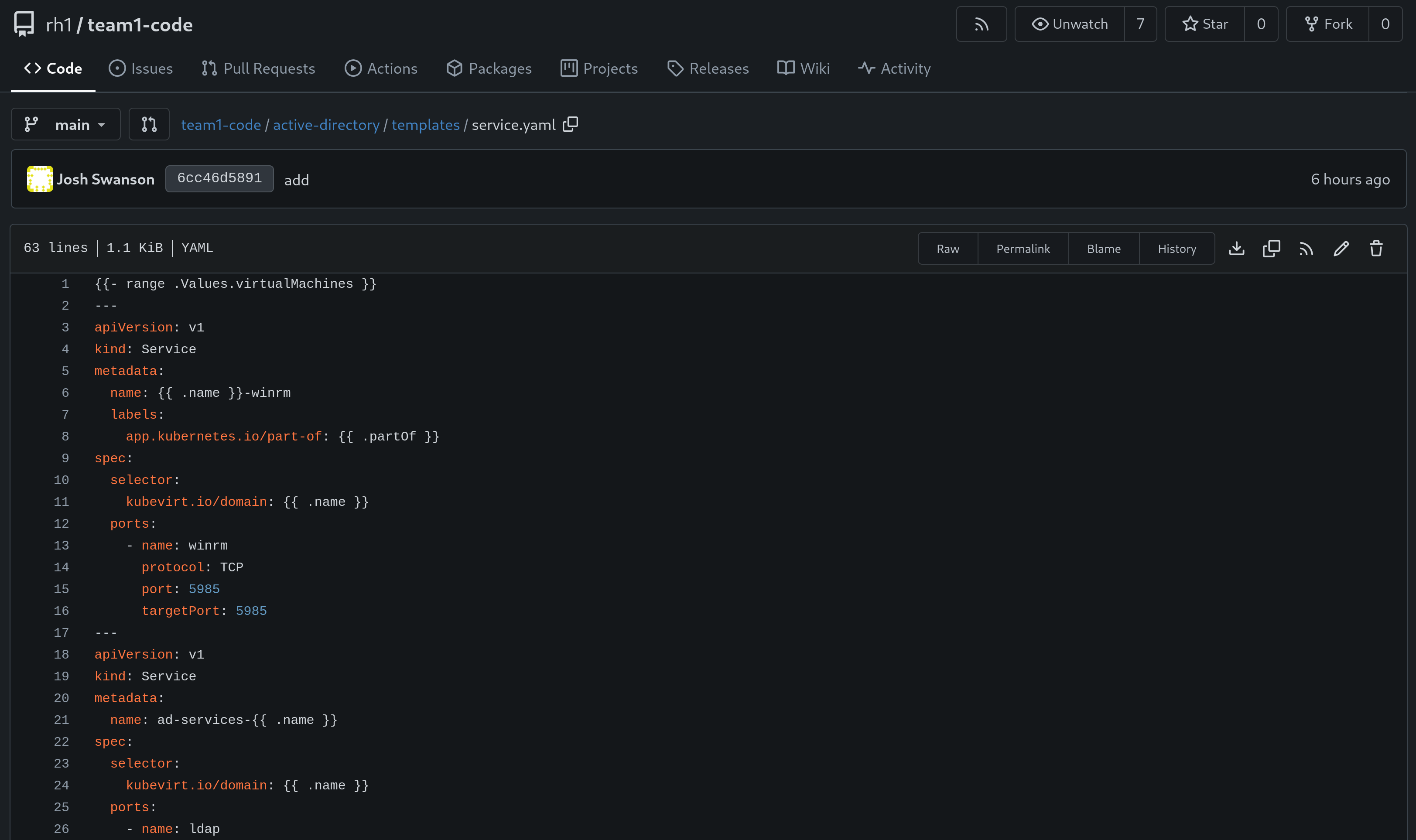Workshop Exercise 1.3 - Adding Services for Connectivity
Table of Contents
- Objective
- Step 1 - Adding Service Templates to the Chart
- Step 2 - Adding a Service for AD Services
- Step 3 - Adding the Service Template to the Code Repo
Objective
- Understand definitions for virtual machines
- Create a template that can be looped
Step 1 - Adding Service Templates to the Chart
Since our virtual machines exist within the normal OpenShift SDN, we’ll need a service to allow things to connect to it, such as Ansible.
We’ll want to have the service provide connectivity to the WinRM port on the Windows VMs, which is port 5985/tcp.
Within the active-directory/templates directory, add a new file named service.yaml, and add the following contents:
{{- range .Values.virtualMachines }}
---
apiVersion: v1
kind: Service
metadata:
name: {{ .name }}-winrm
labels:
app.kubernetes.io/part-of: {{ .partOf }}
spec:
selector:
kubevirt.io/domain: {{ .name }}
ports:
- name: winrm
protocol: TCP
port: 5985
targetPort: 5985
{{- end }}
What’s a bit different in this service is the selector - instead of looking for an app label, the name of the virtual machine is used. This will result in the service attaching to the virt-helper pod of the virtual machine.

In addition, the same looping function is used, so for each VM, a service will be created with the name $(VM_NAME)-winrm.

The fully-qualified hostname of the service will later be used by Ansible Controller to communicate to the virtual machine.

Step 2 - Adding a Service for AD Services
Since Active Directory services work over a network, we’ll need to expose them as well for operations such as domain joins, LDAP, and more.
Return to the service.yaml file created earlier, as we’re going to add a second resource to it. Within the {{- range }} loop, after the existing service, add the following:
---
apiVersion: v1
kind: Service
metadata:
name: ad-services-{{ .name }}
spec:
selector:
kubevirt.io/domain: {{ .name }}
ports:
- name: ldap
port: 389
targetPort: 389
protocol: TCP
- name: ldaps
port: 636
targetPort: 636
protocol: TCP
- name: kerberos
port: 88
targetPort: 88
protocol: TCP
- name: dns
port: 53
targetPort: 53
protocol: TCP
- name: dns-udp
port: 53
targetPort: 53
protocol: UDP
- name: smb
port: 445
targetPort: 445
protocol: TCP
- name: rpc
port: 135
targetPort: 135
protocol: TCP
- name: gc
port: 3268
targetPort: 3268
protocol: TCP
- name: gc-ssl
port: 3269
targetPort: 3269
protocol: TCP
Your modified service.yaml file should now contain:
{{- range .Values.virtualMachines }}
---
apiVersion: v1
kind: Service
metadata:
name: {{ .name }}-winrm
labels:
app.kubernetes.io/part-of: {{ .partOf }}
spec:
selector:
kubevirt.io/domain: {{ .name }}
ports:
- name: winrm
protocol: TCP
port: 5985
targetPort: 5985
---
apiVersion: v1
kind: Service
metadata:
name: ad-services-{{ .name }}
spec:
selector:
kubevirt.io/domain: {{ .name }}
ports:
- name: ldap
port: 389
targetPort: 389
protocol: TCP
- name: ldaps
port: 636
targetPort: 636
protocol: TCP
- name: kerberos
port: 88
targetPort: 88
protocol: TCP
- name: dns
port: 53
targetPort: 53
protocol: TCP
- name: dns-udp
port: 53
targetPort: 53
protocol: UDP
- name: smb
port: 445
targetPort: 445
protocol: TCP
- name: rpc
port: 135
targetPort: 135
protocol: TCP
- name: gc
port: 3268
targetPort: 3268
protocol: TCP
- name: gc-ssl
port: 3269
targetPort: 3269
protocol: TCP
{{- end }}
Same as above, a service will be created for every virtual machine in our list:

Step 3 - Adding the Service Template to the Code Repo
With the template for the services completed, be sure to commit and push the new code if using an IDE, or hit save if using the Gitea web interface.

Navigation
| Previous Exercise | Next Exercise |
